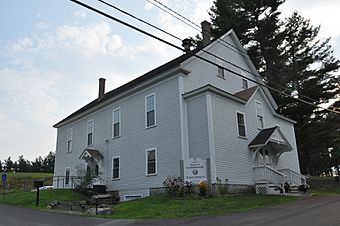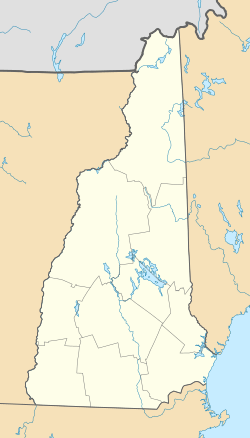Citizens' Hall facts for kids
Quick facts for kids |
|
|
Citizens' Hall
|
|
 |
|
| Location | Lyndeborough, New Hampshire |
|---|---|
| Architect | Lafayette Artillery Company |
| Architectural style | Stick/Eastlake |
| NRHP reference No. | 99001482 |
| Added to NRHP | December 9, 1999 |
Citizens' Hall is an important building in Lyndeborough, New Hampshire. It serves as the town's government office and a place for community gatherings. Built in 1889, it has a unique architectural style. This building is listed on the National Register of Historic Places. It is recognized for its role as a key social center for the town. You can find Citizens' Hall on Citizens' Hall Road in South Lyndeborough village.
Contents
Why Was Citizens' Hall Built?
Citizens' Hall was built by the Town of Lyndeborough between 1888 and 1889. It was meant to be a home for the Lafayette Artillery Company. This group needed a place for their armory and their big annual party. Their yearly "Levee and Ball" had become very popular. Hundreds of guests came to this event. By 1888, the party was too large for other local venues.
The Lafayette Artillery Company decided to buy some land. They wanted to build a new headquarters and social hall. However, they couldn't raise enough money for construction. So, they asked the town for help.
Town Decides to Build
In March 1888, the town held a meeting. After much discussion, they voted to spend $2,000 on a new building. But there was a condition: the building had to serve the whole community. The Artillery agreed to rent space for their office and armory. The town also planned to put a library there. However, the library never ended up in Citizens' Hall.
Some townspeople tried to stop the project. They went to court to challenge the town's vote. Their request was denied. They then called a special town meeting to discuss it again. In September, after more talks, the town decided to move forward. Within days, the foundation was laid.
Designing and Building Citizens' Hall
A special committee designed Citizens' Hall. This group included American Civil War veterans and local politicians. They wanted a simple building. It looked a bit like the nearby Baptist Church. The main part of the building was in the Classical Revival style. Its front faced the road.
However, the front of the building was designed in the Eastlake/Stick style. This was a popular Victorian architectural style. It featured a special roof and decorative supports. These details were common for this style.
Quick Construction
Once the town approved the project, work began quickly. D. C. Grant and Sons led the construction. Building materials came from nearby Wilton, New Hampshire. Some parts of Citizens' Hall look similar to buildings in Wilton.
When people entered the main door, they saw two staircases. These led up to the grand hall on the second floor. The first-floor lobby had a ticket window. Behind it was the Artillery's meeting room. There was also a "clothes room" for coats. The inside walls were gray plaster. The wood trim was off-white. The floors were stained brown.
Beyond the lobby was the banquet hall. Its walls were made of horizontal wooden boards. The armory was in one corner. This is where the Artillery kept their weapons and uniforms. A kitchen was in another corner. It wasn't finished until 1890. A passage connected these rooms to an outdoor restroom.
Second Floor and First Events
The kitchen had a staircase leading to the stage area. This stage was part of the second-floor hall. The ballroom was north of the stage. It had a high 14-foot ceiling and large windows. People could reach the attic from the backstage area.
The Artillery held its first meeting in the building on January 5, 1889. It wasn't fully finished yet. Ten days later, Joel and Esther Tarbell held their golden wedding anniversary there. This was the first public event. Sixteen days after that, the building was officially dedicated. The name "Citizens' Hall" was chosen. It showed that the building belonged to everyone in the community. The first big Levee and Ball was held there on February 22, 1889.
Citizens' Hall Through the Years (1889-1997)
In its early years, Citizens' Hall was the main social spot in South Lyndeborough. The Lafayette Artillery used the ballroom for drills. They also held dinners in the dining room. Most of their weapons were stored there. Their old brass cannon was kept in a nearby shed.
The Artillery also hosted public events. This included the annual Washington's Birthday Levee and Ball. They continued these events until after World War II. For the annual ball, Artillery members would put up a 50-foot flagpole on top of Citizens' Hall. They would fly their company flag from it.
Improvements and Changes
The town spent money to finish the building's inside in the early 1890s. In 1910, they bought a fancy pressed-tin ceiling for the ballroom. In the 1920s, South Lyndeborough got electricity. The Artillery paid to have the building wired. They bought new electric lights to replace the old gas lamps. The original gas lamp above the front entrance was also wired for electricity. These 1920s lights are still used today. They are an important part of the building's history.
In the late 1800s and early 1900s, the Grand Army of the Republic also used Citizens' Hall. This group helped start Memorial Day celebrations in Lyndeborough. Citizens' Hall was important for these events. The Artillery later took over organizing them.
The Grand Army of the Republic also brought a cannon to the hall. This naval cannon was used in the American Civil War. It was placed in front of Citizens' Hall in 1902. It was named the Hartshorn Memorial Cannon. In 1934, the cannon was moved to the South Lyndeborough common. In 2009, it moved again to Lyndeborough Center. The cannon is still in Lyndeborough, but it's on loan from the government.
Decline and New Purpose
By the 1950s, interest in the Lafayette Artillery Company decreased. The Washington's Birthday celebration stopped being an annual event. Citizens' Hall began to fall into disrepair. The town sometimes spent money on repairs. For example, in the 1950s, new windows were installed. A fire-escape door was added to the second floor.
In the mid-1960s, the town's population grew a lot. The annual Town meeting had to move from the old town hall to Citizens' Hall. Soon, other town offices moved in too. These included the Board of Selectmen and the Police Department. A $20,000 renovation took place. Volunteers helped build bathrooms and add heating. Some of the building's original charm was covered up. Neglect continued into the 1990s. The town had to decide: build a new town hall or fix Citizens' Hall properly.
Big Renovation (1998-2000)
By the 1990s, Citizens' Hall was in very bad shape. In 1988, the second-floor hall was closed. It was unsafe due to structural and fire risks. The police department used the space for a few years. During this time, the ballroom got even worse. The ceiling rusted, and the floor wore down. The first floor looked bad too. Town leaders had stopped basic upkeep. They hoped this would make the town vote on the building's future.
Initially, a plan was made to dig out the basement. This would create storage space or a police department. But this plan was stopped. Workers found a natural spring under the building. Also, the Fire Marshal threatened to close the building. It wasn't up to safety codes. An architect even suggested building a new town office.
A Community Effort
In 1998, the town voted on two plans. One was to renovate Citizens' Hall for $263,885. The other was to build a new town hall for $327,500. A third plan was offered by budget committee members. It suggested spending $186,600 to fix the first floor and major problems. They admitted it wouldn't solve all needs. But it would be "better than what we have." This plan also relied on volunteers. After eight hours of discussion, the town voted for the $186,600 plan.
A building committee was formed to manage the renovation. It included builders, former town officials, and local residents. Many volunteers joined the effort. Lafayette Artillery members, a historian, a geographer, and a carpenter helped. Phil Brooks, a builder, coordinated the volunteers. Walter Holland and Walter Holt started the demolition and construction. Stephanie and Scott Roper researched the building's history. They found out which parts should be saved or restored. Scott Roper also helped get the building listed on the National Register of Historic Places in 1999.
Restoring the Hall
Over eighteen months, more than eighty volunteers helped. Local contractors also worked for lower wages. The town completed the renovation. The front hallway, stairs, and second-floor hall were key historic areas. They were restored to look like they did in the 1920s.
The old "clothes room" became the Selectmen's Office. The former Lafayette Artillery office became the office for the Town Clerk and Tax Collector. The old kitchen became the Police Department office. The dining hall was made smaller. It became a meeting room and two offices for the Selectmen. The original pine floor in the dining room was refinished. It became a main feature of the new meeting room.
Volunteers saved so much money. This allowed the committee to renovate the second floor too. It could now be used for public events again. On February 22, 2000, the Lafayette Artillery held its first Washington's Birthday celebration in almost 50 years. This celebrated the renovation's completion. In March, the town held its first Town Meeting in the building since the mid-1980s. A year later, volunteers received awards from then-New Hampshire Governor Jeanne Shaheen.
The renovation also inspired many people. Several committee members and volunteers were later elected or appointed to town government positions.
Citizens' Hall Today
Since 2000, local residents have appreciated Citizens' Hall more. In 2002, the Board of Selectmen voted to paint the building a light gray color. It used to be all white. The new color helps highlight the building's unique 19th-century design.
Today, Citizens' Hall is still used for social events. The Artillery's Washington's Birthday celebration was held annually from 2000 to 2007. The building is also used for town meetings and other community events. Many town offices and committees are located there. These include the Town Treasurer, Town Clerk/Tax Collector, Building Inspector, and Police Department.
Images for kids




